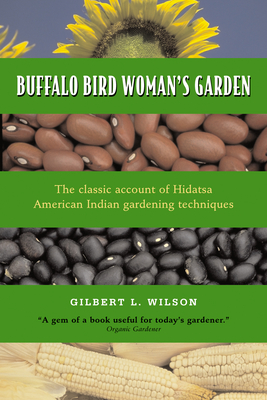
Wilson, Gilbert L.
product information
description
8Buffalo Bird Woman, a Hidatsa Indian born about 1839, was an expert gardener. Following centuries-old methods, she and the women of her family raised huge crops of corn, squash, beans, and sunflowers on the rich bottomlands of the Missouri River in what is now North Dakota. When she was young, her fields were near Like-a-fishhook, the earth-lodge village that the Hidatsa shared with the Mandan and Arikara. When she grew older, the families of the three tribes moved to individual allotments on the Fort Berthold Indian Reservation.
In Buffalo Bird Woman's Garden, first published in 1917, anthropologist Gilbert L. Wilson transcribed the words of this remarkable woman, whose advice today's gardeners can still follow. She describes a year of activities, from preparing and planting the fields through cultivating, harvesting, and storing foods. She gives recipes for cooking typical Hidatsa dishes. And she tells of the stories, songs, and ceremonies that were essential to a bountiful harvest.
A new introduction by anthropologist and ethnobotanist Jeffery R. Hanson describes the Hidatsa people's ecologically sound methods of gardening and Wilson's work with this traditional gardener.
Praise for Buffalo Bird Woman's Garden:
"A gem of a book useful for today's gardener." --Organic Gardener
"One of the best gardening books around." --City Pages
"Every gardener and agricultural scientist should find gems of practical wisdom in these pages, borne from an age-old tradition when sustainable agricultural practices . . . made the difference in sustaining life. Fascinating!" --Foster's Botanical & Herb Review
"Historical photographs and diagrams of farming techniques, along with actual recipes and Hidatsa vegetable varieties, make this gem of a book useful for today'' gardener." --Organic Gardening
In Buffalo Bird Woman's Garden, first published in 1917, anthropologist Gilbert L. Wilson transcribed the words of this remarkable woman, whose advice today's gardeners can still follow. She describes a year of activities, from preparing and planting the fields through cultivating, harvesting, and storing foods. She gives recipes for cooking typical Hidatsa dishes. And she tells of the stories, songs, and ceremonies that were essential to a bountiful harvest.
A new introduction by anthropologist and ethnobotanist Jeffery R. Hanson describes the Hidatsa people's ecologically sound methods of gardening and Wilson's work with this traditional gardener.
Praise for Buffalo Bird Woman's Garden:
"A gem of a book useful for today's gardener." --Organic Gardener
"One of the best gardening books around." --City Pages
"Every gardener and agricultural scientist should find gems of practical wisdom in these pages, borne from an age-old tradition when sustainable agricultural practices . . . made the difference in sustaining life. Fascinating!" --Foster's Botanical & Herb Review
"Historical photographs and diagrams of farming techniques, along with actual recipes and Hidatsa vegetable varieties, make this gem of a book useful for today'' gardener." --Organic Gardening
member goods
No member items were found under this heading.
listens & views

DISNEY'S KARAOKE SERIES: DISNEY ON ...
by DISNEY'S KARAOKE SERIES: DISNEY ON BROADWAY / VAR
COMPACT DISCout of stock
$10.75
Return Policy
All sales are final
Shipping
No special shipping considerations available.
Shipping fees determined at checkout.






